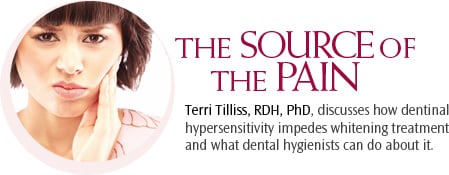
The Source of the Pain
Terri Tilliss, RDH, PhD, discusses how dentinal hypersensitivity impedes whitening treatment and what dental hygienists can do about it.
Q. You recently completed a study that looked at patients’ perceptions of whitening with the results being presented at the upcoming North American Research Conference in June. What were the key points learned from the study?
A. Our study examined people’s perceptions about tooth whitening in general. We were very interested in what people think of as an appropriate level of whiteness. We interviewed two groups of people—one was composed of people who whiten their teeth very frequently and the other was those who have used whitening products once or twice. The study included qualitative interviews and a visual part where the participants were shown various photographs of people with different shades of teeth and then asked to decide on the age range of the individuals pictured and to assess whether the color of their teeth was appropriate.
One factor we wanted to evaluate was whether people perceive individuals to be younger when their teeth appear whiter. The frequent whitening group was somewhat more likely than the occasional whitening group to evaluate age as younger when teeth are lighter. Also, the frequent whitening group was more likely to feel that brighter teeth are “just right” and darker teeth “too dark.” The occasional whitening group was somewhat more likely to assess that brighter teeth are “too light” than the frequent whitening group. When asked what the appearance of teeth communicates to others, the most frequent answer from both groups was “overall health and well-being.” This last finding was a surprise to us: we didn’t realize that people associated great looking teeth as representing “health.”
We also learned that people are very confused about tooth stains and what can or can’t be whitened. Participants also reported being confused by the wide variety of products available for tooth whitening. One major misconception that almost all of our participants had was that they felt they needed tooth whitening because they either drank a lot of coffee or tea or they smoked. As dental hygienists, we know that most of the time these kinds of stains are extrinsic and thus can be removed by a dental hygienist with scaling and polishing. Dental hygienists need to educate their patients about what conditions are indicated for whitening and what conditions are better addressed with a dental hygiene appointment. Dental hygienists can also recommend at-home approaches that can better control stain build-up.
Almost all of our study participants reported dentinal hypersensitivity as a negative result of whitening treatment. The pain experienced due to the whitening treatment led many participants to discontinue the whitening treatment or to become adverse to trying it in the future.
WHITENING-INDUCED SENSITIVITY
Q. Why does whitening treatment cause dentinal hypersensitivity?
A. Open dentinal tubules are the culprit behind dentinal hypersensitivity. When a stimulus comes in contact with dentin, a disturbance of the fluid within the dentinal tubule occurs. The fluid movement then stimulates the nerve endings located at the junction of the dentin and the pulp, causing pain. This process occurs when the dentinal tubules are open at the junction of the enamel or cementum and dentin, where the stimulus will first be transmitted. When the protective positioning of the gingiva is altered, it leaves the cementum vulnerable to being abraded or eroded or both, resulting in dentin exposure. Sensitivity is likely to continue if the exposed dentinal tubules remain open.
Sensitivity is a common side effect of tooth whitening because of the chemical by-products in carbamide or hydrogen peroxide—the active ingredient in tooth whitening products. When either stimulates movement of the fluid in the dentinal tubules, the nerve endings are signaled, causing sensitivity.
TREATMENT PLANNING
Q. How is whitening-induced dentinal hypersensitivity best treated?
A. Over-the-counter desensitizing dentifrice containing potassium nitrate is the most often recommended first line of defense. In addition to the nerve soothing effects of the potassium nitrate, the abrasive particles in any toothpaste can also help occlude the tubules. When whitening causes severe sensitivity, more definitive treatments that are applied in the dental office or via prescription may be indicated. See Table 1 for a list of professionally applied treatments for dentinal hypersensitivity.
As all dental hygienists know, the indicated use of fluoride varnish is for the inoffice treatment of dentinal hypersensitivity. At this time, dental hygienists could recommend that their patients return to the dental office immediately after whitening-induced sensitivity starts for an application of fluoride varnish. It would be interesting to know whether a fluoride varnish treatment prior to the whitening procedure could decrease or prevent sensitivity. Currently, fluoride varnish is not indicated for at-home use, so a visit to the dental office is necessary to receive an application.
Q. Why is fluoride varnish so effective?
A. Fluoride addresses dentinal hypersensitivity with two mechanisms. One is that the fluoride particles actually block the dentinal tubules so that the stimulus (cold air, sharp instrument, whitening gel) doesn’t cause tubular fluid flow. Fluoride also helps narrow the tubules by calcifying them so that the stimulus is not as easily able to signal fluid movement.
From Dimensions of Dental Hygiene. April 2009; 7(4): 24, 26.

